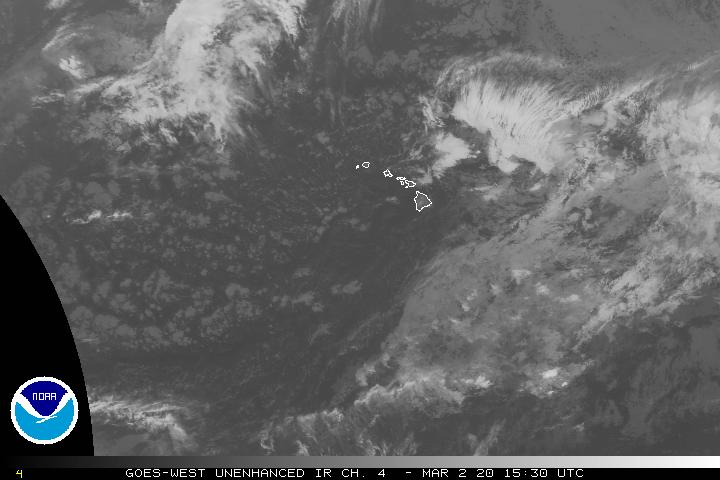Air Temperatures – The following high temperatures (F) were recorded across the state of Hawaii Monday…along with the low temperatures Monday:
80 – 75 Lihue, Kauai
84 – 75 Honolulu, Oahu
87 – 77 Molokai AP
89 – 76 Kahului AP, Maui
88 – 75 Kailua Kona
82 – 73 Hilo AP, Hawaii
Here are the latest 24-hour precipitation totals (inches) for each of the islands Monday evening:
12.88 Mount Waialeale, Kauai
1.95 Poamoho RG 1, Oahu
0.37 Molokai
0.53 Lanai
0.01 Kahoolawe
1.49 Puu Kukui, Maui
4.86 Waikii, Big Island
The following numbers represent the strongest wind gusts (mph) Monday evening:
16 Mana, Kauai
22 Oahu Forest NWR, Oahu
18 Molokai
18 Lanai
32 Kahoolawe
20 Maalaea Bay, Maui
18 Kaloko-Honokohau, Big Island
Hawaii’s Mountains – Here’s a link to the live webcam on the summit of our tallest mountain Mauna Kea (nearly 13,800 feet high) on the Big Island of Hawaii. Here’s the webcam for the 10,000+ feet high Haleakala Crater on Maui. These webcams are available during the daylight hours here in the islands, and at night whenever there’s a big moon shining down. Also, at night you will be able to see the stars, and the sunrise and sunset too…depending upon weather conditions.
Aloha Paragraphs

Tropical Depression Lane will continue moving off to the west-southwest of the state / Tropical Storm Miriam remains active in the eastern Pacific, well east-southeast of Hawaii, and will head towards us…although will likely veer to the north when it reaches within about 900+ miles to our east-southeast (click images to enlarge)
Tropical Depression Lane still has associated thunderstorms streaming from its center

Showers locally and offshore…a few are still heavy
Looping image
~~~ Hawaii Weather Narrative ~~~
Broad Brush Overview: A trailing band of deep tropical moisture from Tropical Storm Lane, will keep windward areas showery through tonight, while leeward areas see a few showers from time to time. Drier, more typical trade wind weather is expected to move in from east to west across the state Tuesday, with quite comfortable weather expected Wednesday through Friday…with noticeably lower humidity levels. A more showery trade wind pattern may return by the weekend.
Details: Tropical Storm Lane is forecast to track westward, before making a turn toward the north Tuesday through the end of the work week. Meanwhile, high pressure will remain in place well to the north of the state through the weekend, keeping trade winds blowing across the island chain. Moderate trade winds are expected through tonight, becoming a bit stronger Tuesday through Thursday. The trades are then expected to back-off Friday through the weekend…as low pressure approaches or moves over the state.
Here’s a near real-time Wind Profile of the Pacific Ocean – along with a Closer View of the islands / Here’s the latest Weather Map / Here’s the latest Vog Forecast Animation / Here’s the Vog Information website
Marine Environmental Conditions: Locally strong trades will persist through at least Wednesday. Tropical Cyclone Miriam is forecast to enter the Central Pacific Hurricane Center area of responsibility Wednesday afternoon. Miriam’s track has the storm moving north once it crosses 140W longitude. It is uncertain at this time what strength the trades will be after Thursday, it all depends on Miriam’s track, although a surface trough may form just east of the Big Island…making our local trades lighter in the process.
Surf will be small through the upcoming weekend, although there will be swells from the northwest, south, and southwest to keep the surf from becoming flat. The largest of the south swell is due in over the weekend.

World-wide Tropical Cyclone Activity
Here’s the Tuesday Pacific Disaster Center (PDC) Weather Wall Presentation covering the Atlantic Ocean
Here’s the latest Pacific Disaster Center (PDC) Weather Wall Presentation covering the Pacific and Indian Oceans, including Tropical Depression 14E (Lane), and Tropical Storm 15E (Miriam), and Tropical Cyclone 25W (Jebi)
>>> Atlantic Ocean: No active tropical cyclones
>>> Caribbean Sea: No active tropical cyclones
>>> Gulf of Mexico: No active tropical cyclones
Tropical cyclone formation is not expected during the next 5 days.
Here’s a satellite image of the Caribbean Sea…and the Gulf of Mexico
Here’s the link to the National Hurricane Center (NHC)
>>> Eastern Pacific:
Here’s what the computer models are showing for this tropical storm
According to the NHC…Miriam is moving toward the west near 12 mph, and this motion is expected to continue through Wednesday. A turn toward the northwest and north-northwest is expected Thursday and Friday. Maximum sustained winds remain near 65 mph with higher gusts. Some strengthening is forecast during the next 48 hours, and Miriam is expected to become a hurricane later today or tonight. Tropical-storm-force winds extend outward up to 60 miles from the center.
>>> Meanwhile, a tropical disturbance, being referred to as Invest 90E is active
1.) According to the NHC…Showers and thunderstorms associated with an area of low pressure located about 550 miles south-southwest of the southern tip of the Baja California peninsula have changed little in organization overnight. However, environmental conditions are still conducive for development, and a tropical depression is expected to form later today or on Wednesday while the system moves west-northwestward at about 10 mph.
* Formation chance through 48 hours…high…90 percent
* Formation chance through 5 days…high…90 percent
2.) Another area of low pressure is forecast to form well southwest of the coast of southwestern Mexico in a few days. Some gradual development of this system is possible by the end of the week while it moves west-northwestward or northwestward farther away from the coast of Mexico.
* Formation chance through 48 hours…low…near 0 percent
* Formation chance through 5 days…low…30 percent
>>> Central Pacific:
Here’s what the computer models are showing for this tropical depression
According to the CPHC…The depression is moving toward the west near 7 mph. Lane is forecast to turn to the northwest overnight, then to the north- northwest on Tuesday. Maximum sustained winds are near 35 mph with higher gusts. Slight weakening is forecast during the next 48 hours. Lane is forecast to become a remnant low late tonight or Tuesday morning. The remnant low is then expected to dissipate on Wednesday, as it becomes absorbed into a developing extratropical low farther to the north.
>>> Northwest Pacific Ocean:
Tropical Cyclone 25W (Jebi)
JTWC textual advisory
JTWC graphical track map
>>> South Pacific Ocean: No active tropical cyclones
Here’s a link to the Joint Typhoon Warning Center (JTWC)
Interesting: Why Does the Earth Rotate? – Every day, the Earth spins once around its axis, making sunrises and sunsets a daily feature of life on the planet. It has done so since it formed 4.6 billion years ago, and it will continue to do so until the world ends — likely when the sun swells into a red giant star and swallows the planet. But why does it rotate at all?
The Earth formed out of a disk of gas and dust that swirled around the newborn sun. In this spinning disk, bits of dust and rock stuck together to form the Earth, according to Space.com. As it grew, space rocks continued colliding with the nascent planet, exerting forces that sent it spinning, explained Smadar Naoz, an astrophysicist at the University of California, Los Angeles. Because all the debris in the early solar system was rotating around the sun in roughly the same direction, the collisions also spun the Earth — and most everything else in the solar system — in that direction.
But why was the solar system spinning in the first place? The sun, and the solar system, formed when a cloud of dust and gas collapsed due to its own weight. Most of the gas condensed to become the sun, while the remaining material went into the surrounding, planet-forming disk. Before it collapsed, the gas molecules and dust particles were moving all over the place, but at a certain point, some gas and dust happened to shift a bit more in one particular direction, setting its spin in motion. When the gas cloud then collapsed, the cloud’s rotation sped up — just as figure skaters spin faster when they tuck their arms and legs in.
Because there isn’t much in space to slow things down, once something starts rotating, it usually keeps going. The rotating baby solar system in this case had lots of what’s called angular momentum, a quantity that describes the object’s tendency to keep spinning. As a result, all the planets likely spun in the same direction when the solar system formed.
Today, however, some planets have put their own spin on their motion. Venus rotates in the opposite direction as Earth, and Uranus’ spin axis is inclined 90 degrees. Scientists aren’t sure how these planets got this way, but they have some ideas. For Venus, maybe a collision caused its rotation to flip. Or maybe it began rotating just like the other planets. Over time, the sun’s gravitational tug on Venus’ thick clouds, combined with friction between the planet’s core and mantle, caused the spin to flip. A 2001 study published in Nature suggested that gravitational interactions with the sun and other factors might have caused Venus’ spin to slow down and reverse.
In the case of Uranus, scientists have suggested that collisions — one huge crash with a big rock or maybe a one-two punch with two different objects — knocked it off kilter, Scientific American reported.
Despite these kinds of disturbances, everything in space rotates in one direction or another. “Rotating is a fundamental behavior of objects in the universe,” Naoz said.
Asteroids rotate. Stars rotate. Galaxies rotate (it takes 230 million years for the solar system to complete one circuit around the Milky Way, according to NASA). Some of the fastest things in the universe are dense, whirling objects called pulsars, which are the corpses of massive stars. Some pulsars, which have a diameter about the size of a city, can spin hundreds of times per second. The fastest one, announced in Science in 2006 and dubbed Terzan 5ad, rotates 716 times per second.
Black holes can be even faster. One, called GRS 1915+105, may be spinning anywhere between 920 and 1,150 times per second, a 2006 study in the Astrophysical Journal found.
But things slow down, too. When the sun formed, it spun once around its axis every four days, Naoz said. But today, it takes about 25 days for the sun to spin once, she said. Its magnetic field interacts with the solar wind to slow its rotation, Naoz said.
Even Earth’s rotation decelerates. Gravity from the moon pulls on Earth in a way that ever so slightly slows it down. A 2016 analysis in the journal Proceedings of the Royal Society A of ancient eclipses showed that Earth’s rotation slowed by about 6 hours over the last 2,740 years. That comes out to just 1.78 milliseconds over a century.
So, while the sun will rise tomorrow, it just may be a tad late.

















 Email Glenn James:
Email Glenn James:
Jay Says:
The last hour in upper Kula we saw the heaviest rain yet for the Lane event…just when you think it might be going away…easing up now
~~~ Hi Jay, thanks for the report! Actually, we knew Lane was taking its weakening winds away, although expected locally heavy showers in his wake for a while longer.
Stay dry Jay!
Aloha, Glenn
Deb Says:
Hi glenn have my trip to maui (lahina area) starting 9/1 . Was wondering because of hurricane if weather forecast shows a week of rain ? Can postpone. What do u think thank You
~~~ Hi Deb, good question of course, here’s a link to the most up-to-date forecasts for the Lahaina area. You can keep checking back on a daily basis, if you like, as they are updated 4-times per day.
https://www.hawaiiweathertoday.com/maui.php?zone=HIZ018
Best of luck, I personally wouldn’t cancel my trip to generally dry Lahaina town.
Aloha, Glenn